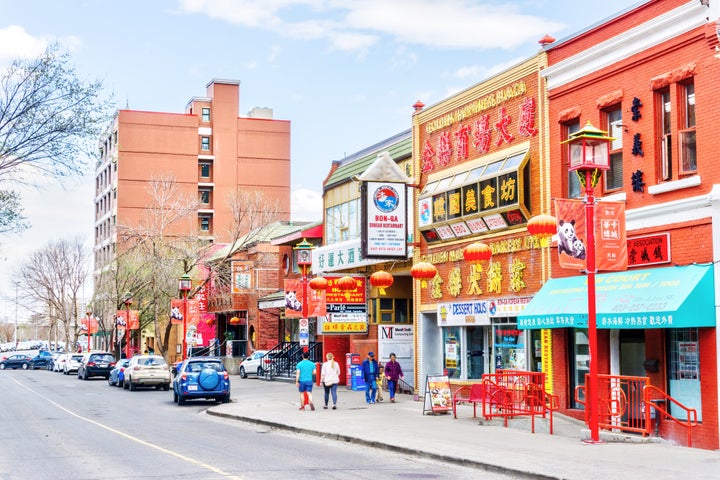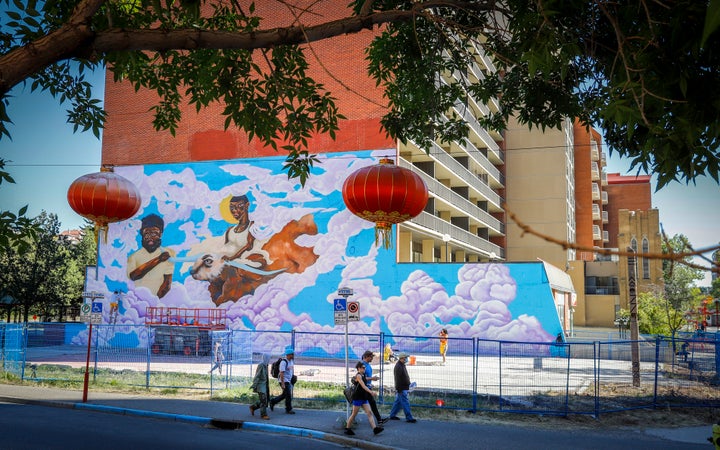What should be a celebration of racial diversity and the vision of young Canadian artists threatens to divide communities in Calgary at a time when solidarity is needed most.
This summer, Pink Flamingo (an offshoot of the Black Lives Matter movement) was granted city approval to paint a mural in a parking lot across from the Calgary Chinese Cultural Centre.
Calgarian Jae Sterling, one of the artists behind the mural, noted “it’s very important for us to have representation in the city. A lot of immigrants in this city [grew up feeling like] they had to fight to [be] welcomed and to not feel like outsiders.”
Named “The Guide and the Protector,” the art is loosely inspired by John Ware, one of the first Black people to arrive in Alberta. Formerly an American slave, he became a successful rancher in the province. Many places in and surrounding Calgary have Ware’s namesake, such as the creek I walked along last August. This building-sized mural in a central part of the city is a recognition of Canada’s Black heritage, and challenges the prevailing idea of Alberta as a space with no Black stories.

Calgary’s Chinatown developed quickly since its establishment in the early 1900s, providing support to Chinese immigrants amid the undisguised racism of the “Yellow Peril” era.
As a first-generation Hong Kong immigrant growing up in Calgary in the early 2000s, Chinatown meant dreaded Saturday Chinese school classes, and shops selling live fish and bok choy — experiences to avoid as a third-culture kid navigating social circles in the Prairies.
But as young adults grow into themselves, feelings evolve. Chinatown, I realized, is a recognition of the hard-fought experience in Alberta and Canada — one where Chinese immigrants were the only ethnic group forced to pay an entry tax, and one that saw a Chinese Exclusion Act in place until 1947. The neighbourhood holds 130 years of memories, which for my generation meant weddings at Silver Dragon and Sunday dim sum at U & Me. Thus, much like a century ago, it is still a neighbourhood for social gatherings and community support.
With Chinatown playing such a central role in the Chinese experience in Calgary, some questioned the introduction of a Black story into the area. A troubling video being circulated by Rebel Media (and viewed 240,000 times at the time of writing) frames Pink Flamingo’s project as intentionally harmful to the city’s Chinese community.
Its interviewer is armed with loaded phrases and questions seemingly constructed to encourage resentment. He asks Chinese passersby if it’s “fair [the group] comes here and takes up your space?” The video further advocates that the mural is importing American problems, as “no Black slave has ever died in Alberta.”

Such sentiments are echoed on social networks and in digital publications frequented by Gen Y and Z Asians in North America. For instance, Korean influencer Nicky Park insisted on Instagram that “Asians standing up for Blacks is the ‘stupidest thing’ she has ever seen.” Comments like hers tend to highlight Black-on-Asian violence (mainly in the U.S.), and argue that Black communities don’t do enough for Asians. They question why we need to stand up for Blacks, given that Asians suffer racist vitriol, too — especially during this pandemic, serving as a scapegoat for blame and abuse.
But such rhetoric asks the wrong questions and exacerbates divides. Chinese-Canadians cannot be looking for return on investment when it comes to empathy and solidarity, and calculating which community has suffered more. Recognizing and remembering Black cultural legacies and heritage doesn’t come at the expense of our own.
The inconvenient truth is that intolerance, institutional inequality and anti-Black prejudices exist in Canada, which indelibly extends to Chinese-Canadian homes, too.
Assigned to Chinese and Asian-Canadians is the pernicious “model minority” stereotype; while Black communities are frequently afforded the opposite. As American activist Helen Zia said, “To say that this minority is the ‘good minority’ means you’re essentially saying there’s a ‘bad minority.’”
Viewing society through this prism allows us to ignore ongoing structural inequities in society, and hearkens back to colonial race hierarchies — of “white” races at the top, then Asians and other races who are “not quite white,” and Blacks consigned to the bottom.

“The pain is too intense for one community to bear alone,” said U.S. Presidential candidate Joe Biden recently, in response to George Floyd’s death. The injustice of the continued, preventable loss of Black lives in America; and the sustained erasure of Black stories in many countries, should be enough for us to stand with the Black community.
Solidarity and understanding means having difficult conversations in society and in our homes. We must question the uninformed myths at the root of our prevailing prejudices.
We need to ask ourselves, how do we envision Chinatown, our city and country moving forward?
Most Chinese-Calgarians, I believe, do not oppose Black presence in Chinatown. As one leader from the Chinatown community said, the issue lies in process rather than opposition to the Black Lives Matter movement or the artists. Rather, residents regret the missed chance for community input and collaboration on the mural, a chance to strengthen ties between Asian and Black Canadians even further.
With the mural recently completed, there are only more opportunities ahead for greater discussions and engagement in cross-cultural initiatives.
The best of Canada shines through its unity in diversity, when the sorrows, joys and milestones of all our communities are shared. While Chinatown’s historic role was a haven for new migrants from China, today it serves as a space for all of Calgary’s diverse communities.
Perhaps Chinatown’s modern renaissance will re-envision our communities and be best served by this mural of a humble cowboy.
Have an opinion you’d like to share on HuffPost Canada? You can find more information here on how to pitch and contact us.
Also on HuffPost: